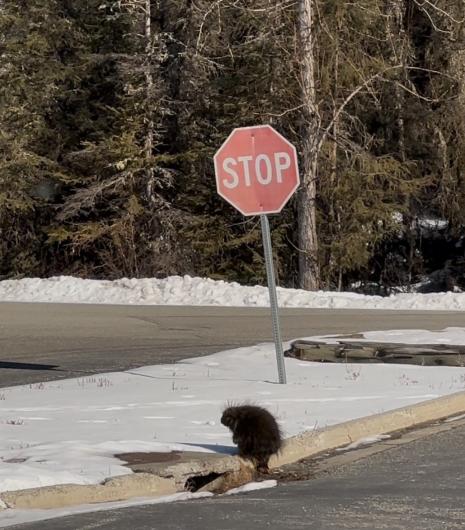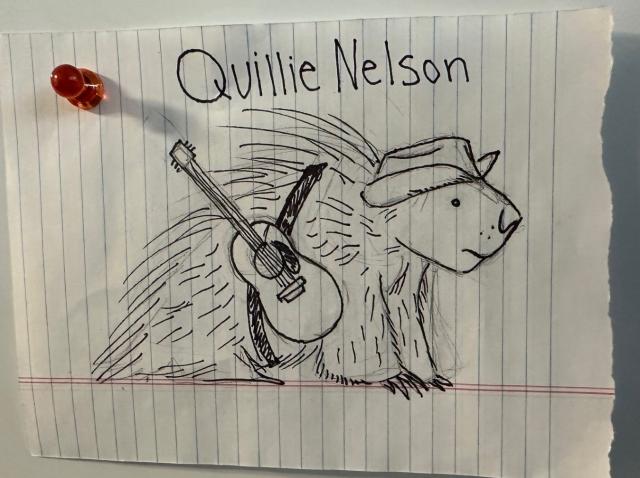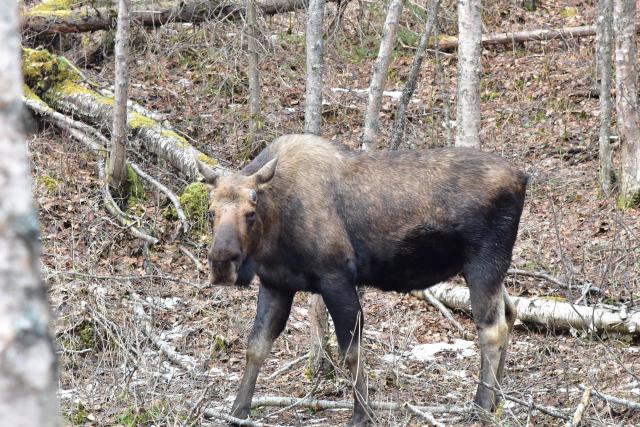Quillie Nelson: A resident rodent of Campbell Tract
Boredom is a hard thing to come by when your office is surrounded by 730 acres of boreal forest. BLM's Anchorage District Office (ADO) sits neatly in the middle of Campbell Tract Special Recreation Management Area (CT), the most visited recreation site for BLM Alaska and a hub for all sorts of activities. The latest excitement to come from working right next to the woods? A porcupine dubbed “Quillie Nelson.”
Jenny Blanchard, an archeologist at ADO, first spotted Mr. Nelson on January 30th. He was sitting on a storm drain just outside her window and basking in the sun, which seems to be his favorite thing to do. At first it seemed that his visit may have been a fluke, but sightings of the prickly visitor became more frequent throughout the month of February.

When it became evident that Mr. Nelson was around to stay, the staff at ADO decided that their new resident needed a name. Blanchard and her coworkers that also had a view of the storm drain compiled a list of suitable porcupine names, then sent out a poll to everyone at ADO so they could vote on the name. After two rounds of voting, Quillie Nelson was the victor. Runners-up included "Stabitha," "Quilliam," “Sergeant Prickles,” and "Quill Nye the Porcupine."
Quillie’s popularity is growing rapidly in the field office. “He’s the highlight of everyone’s day,” says Blanchard. “Every time he pops up, we send a message [to the office] and half a dozen people come to see him.” Peyton Edelbrock, the SCA cultural resource management intern at ADO, says that “people definitely seem happier when there’s a Quillie sighting.” Scott Claggett, Public Affairs Specialist at the adjoining District Office, says Quillie presents a daily spotlight on wildlife diversity and serves as “a tangible reminder of all the different animals we have across our public lands.”

Craig Townsend, a wildlife biologist at ADO, explains that a lot of people come to CT specifically for the opportunity to observe wildlife like Quillie. “Given its location [in an otherwise urban environment], CT ends up being a corridor for all kinds of critters.” However, Townsend cautions against letting your guard down when viewing wildlife.
“It’s super important to maintain situational awareness when visiting and recreating,” Townsend says, urging people to remember that wildlife is still wild. Moose calving season is in mid-May, and mothers are especially aggressive during the first few weeks of their calves’ lives. Bear season varies a bit more, but they’ve already shown signs of becoming active in CT.
Situational awareness makes all the difference in wildlife encounters, and Townsend says it doesn't take much to stay aware. The first aspect of situational awareness is having your senses available to you. This means forgoing noise-cancelling headphones and keeping your line of sight clear. Other aspects include being aware of high use areas, carrying deterrents like bear spray, and securing food or garbage or anything that would attract a bear. The highest bear concentration in CT is on Campbell Creek itself, and their presence is typically indicated by tracks and scat. It’s also important to keep your pet on a leash at all times, since moose and bears are likely to view them as a threat.

Generally, running from moose is the right thing to do since they typically only attack people out of defense. For bears, statistics have shown that recreating in groups of more than two people significantly reduces the likelihood of negative bear encounters. If you do encounter a bear, NEVER run from them. Stand your ground and use deterrents if necessary. For smaller creatures, the best thing to do is respect their territory and give them plenty of distance. “A porcupine is probably not gonna chase you down,” reassures Townsend.
Obviously, no one at ADO has gotten close enough to Quillie to confirm his gender, but some people in the office hope that he might turn out to be a she. If so, the storm drain might soon become a nursery, and ADO would have a baby porcupine—a porcupette—to fawn over.
Jordan Oldenburg, ACE member
Related Stories
- Lake Havasu Fisheries Improvement Program is the gift that keeps giving
- Historic Umtanum Suspension Bridge wins international footbridge award
- Building for birds: Scouts support public lands
- BLM Eastern States enhances campsites on Black Duck Lake
- Virtual adventures await: Discover six BLM public lands you can tour from anywhere
